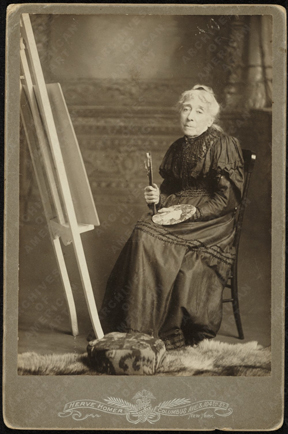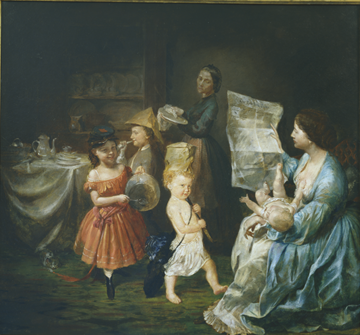Art Essay: Lilly Martin Spencer and War Spirit at Home: A Provocative Voice
By Rena Tobey©
ART TIMES Fall 2014
 Lilly Martin Spencer, ca. 1900. Archives of American Art, Smithsonian Institution |
The paintings of Lilly Martin Spencer (1822-1902) often reveal the personal joys and challenges of her life, while also acting as a metaphor for issues faced by 19th-century Americans. Looking closely at one of Spencer’s better-known works—War Spirit at Home, from 1866—shows how she navigated the country’s changing sense of itself. The painting depicts a noisy, seemingly happy household moment of work and play. It noticeably lacks a male presence. Spencer’s own home was non-traditional. She was the breadwinner, with a husband who worked in supporting her career and the care of their seven surviving children of 13. Domestic chores were an insistent part of their lives, as well as an ongoing financial pressure, but Spencer generally employed a servant to help with the ensuing domestic chaos.
In War Spirit at Home, Spencer highlights the woman reading a newspaper, in the new role of the indirect eyewitness. The newspaper was viewed as a symbol of authority, and because it reported news from the world, it also stood in as a symbol of the public sphere, the male domain. Here, news consumption has been moved into the domestic sphere, with no men to make this activity more acceptable. It also charges the scene with historic significance. The Civil War was considered the first ‘living room war’, with photography providing graphic images of what war really looked like and illustrations of battle and camp life scenes. Having a woman read such potentially distressing information indicates how the Civil War upturned convention, giving women agency in new ways.
With the printed word, the mother has the power usually held by the father. She reads the battlefield news aloud. The baby in her lap touches her breast, while a foot kicks out at the newspaper. Symbolically, the infant links the mother’s roles in the home and as a witness and interpreter of history. The newspaper also divides the mother from her other children, leading some to critique her as indifferent or absent minded. With the mother’s precarious hold on the baby, Spencer may also allude to her own juggling of the two spheres, since painting sales were crucial to the family’s domestic comfort.
Still domestic chores must be attended to, no matter what is happening in the broader public sphere. In War Spirit at Home, the servant continues to conduct her duties, no matter what else happens in the scene. The servant handles her domestic chores with a kind of humble dignity, dressed modestly in black, melting into the darker background of the painting. The power difference between the mother and the servant is clear—the servant works, while the mistress is at leisure enough to read the newspaper. But as the tallest figure, the servant is important, contrary to the authority afforded to the mother by her literacy.
How do we read the servant’s expression? Is it empathy for the pressures and responsibilities this mother bears? A sign of the servant’s own exhaustion? Her expression might also show disapproval. With the messy interior, the noisy children, the seeming disregard for the safety of the infant while the newspaper has the mother’s full attention, the servant can be read as criticizing household management. Traditionally in paintings, a messy, chaotic household suggests a society in disarray. The servant could represent societal criticism: this house is disorganized and out of control, as is the country during the Civil War. Further, the disdain on the servant’s face might reflect Spencer’s tensions with her servants. She complained about servants being lazy, dishonest, and thieving. The war spirit at home may refer to the mistress-servant relationship. This servant has been placed at a distance, relegated to work outside the family circle.
 Lilly Martin Spencer The War Spirit at Home, 1866, Oil on canvas, 30" x 32 ¾". Purchase 1944 Wallace M. Scudder Bequest Fund. Collection of the Newark Museum |
Her turned head could also be understood as listening and concerned, as the mother reads the war news. Perhaps this wife has lost a husband in the battle or is concerned for his safety, consistent with her downturned lips and seeming disregard for the infant and other children. The servant’s skin is painted darker than the other figures. Spencer’s facility with painting faces would suggest that she used a darker skin tone to open up the conversation about the race of the servant. If the servant is African American, the quizzical look may suggest that she hears the war news with different ears. A reported Vicksburg victory means the likelihood of the overall Union success, and African American lives would be profoundly changed. By 1866, Spencer would have known that this battle was the turning point in the Union’s favor, and the future of African Americans was on everyone’s minds.
The future is also unclear for the children, who are depicted in a more exaggerated style. Children in paintings represent the future, and in Spencer’s commercially successful works were often shown as little angels. These rambunctious children, celebrating a battle they cannot fully understand, play soldier, embodying the manly virtue of courage, again blurring the distinctions between the spheres. They play-act the battle, while also celebrating the victory reported in the newspaper. The war has been brought into the home, not just in word, but also in deed, through the mock parade.
This improvised party features improvised props. The toddler in the center carries a stick as a rifle over one shoulder and wears a paper hat. The boy in the back also wears a paper hat and blows a toy horn. The girl, modeled on Spencer’s daughter Angelique, bangs a cooking pot with a spoon as a makeshift drum. The girl makes the most noise, converting the kitchen utensil into an aggressive, noisy instrument—very unladylike—representing the kind of noise Spencer herself had to make to succeed in a man’s professional world. The girl wears the brightest color, a red dress sure to grab the viewer’s eye, and the patriotic mate to her mother’s blue and white gown. The color binds the two and suggests that women will be central to patriotic service for the country coming out of the war. The girl is the only child to wear an actual Union cap, called a kepi, not a paper hat like her brothers. She is not just playacting at being a soldier. By wearing a real hat versus a paper hat, she seems to say, “I can fight, too, for the future of this country.” Her march may become that for women’s rights, which resurged after the Civil War. Her marching is more than child’s play. It has real goals and desired outcomes for new freedoms.
As allegorical figures, the mother and daughter show how to mend the nation, rising above the upheavals in the parlor and in the country. With the loss of so many men (and their patriarchal authority), the mother represents moral and social order, while also engaging with the outside world. The energized tomboy suggests the changes coming out of the turmoil of war. Her dress is in disarray, falling off her shoulder; the untied ribbon trailing. She needs tending, like cleaning up the country’s mess.
The mother can also be read as a religious figure and as representative of all women who suffer from war. The baby laid across the mother’s lap can be understood as a Pietá, and the newspaper has been folded and now reopened to reveal a cross shape in the creases. Her seriousness represents Christian suffering from the pain of war and sacrifices for her family, unrecognized by the raucous children. Women viewers, whether wives, daughters, or sisters, would have responded to this implied grief. The children’s innocent joy is tempered by the adult understanding of the deeper losses from this, and any, battle.
War Spirit at Home subverts convention. No male figure provides order to the scene. The mother, generally seen as responsible for moral uplift, has a messy home with unruly children. She is a reader of news. The girl marches as a vision for the future, not as make believe. The issues of the day—the Union cause, the future for African Americans, women’s suffrage—have invaded the domestic sphere of nursing mothers and domestic help. Spencer may paint the parlor, but she would not descend to stereotypes. She gave the viewer a mother-and-child scene, appropriate for her gender, but she did not shut off the outside world. She coded the image with wry suggestions that triggered recognition of contemporary issues and debates.
Spencer lived to be eighty, but never retired, unable to achieve financial security. She was still seeking commissions to make ends meet into her late 70s. She died while painting at her easel. Her work then fell into obscurity, as critics labeled it inferior. But paintings like War Spirit at Home are too potent, sparking perpetual debate on the artist’s intentions and dialogue with the issues of her day. Her works quickly deepen with wit, charm, and intelligence to comment on a turbulent period with a distinctive American voice, projected by a remarkable, pioneering woman.
